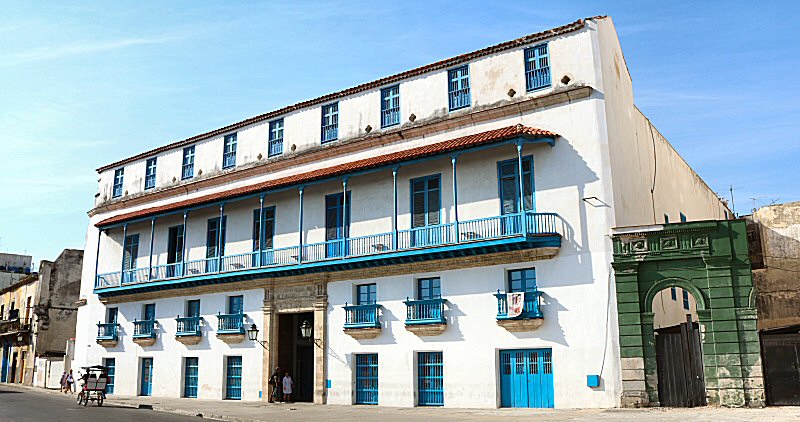
The Palacio de la Artesanía is located
on the Cuba street #64, between the Cuarteles and the Peňa Pobre
streets.
The mansion was built at the end of
1780. Its owner was the city councilor and the mayor Mateo
Pedroso y Florencia, one of the most influential figures of
the colonial government. The building is considered one of
the most representative and best-preserved Havanan
residencies of the time. The ground floor was occupied by
shops. The servants were living on the mezzanine, while the
owners were using the upper floor as their residence. The
number of the slaves that live in the house, were attracting
notice; according to the Countess of Merlin (María de las
Mercedes Beltrán Santa Cruz y Cárdenas Montalvo y O'Farrill)
that lived here in 1842, as mentioned in her letters, more
than hundred African slaves were accommodating in the manor.
In 1854 the house was occupied by the Royal Audience (a kind
of Supreme Court, being created by a royal decree of
Fernando V of Castle, issued in 1511). In 1897 it became the
Police Headquarters. At the beginning of the 20th century it
became a tenement house. In 1938 it was carefully restored
by the architect Joaquín E. Weiss, and Francisco de Paula
Peñalver y Pedroso, a descendant of the first owner, took
the possession of the building. Soon, it was refurbished for
its present role as a recreational, commercial, historical
and cultural complex, where in plenty of shops handmade
goods, cigars, cigar related products, rums are sold, as it
is typical in Havana.
The Baroque-style building looks out
onto the Havana bay. It has a sober façade with a wooden,
Moorish type balcony. 32-meters long, continuous balcony is
one of the longest, built in Cuba. All the carpentry at the
façade is painted in blue, as usual in other colonial
mansions in Havana. Similar to other buildings of the time,
it has a central courtyard and a backyard. The spacious
inner courtyard is surrounded by four galleries with wooden
balustrades, and large stone columns, supporting arches. The
stones, used in the construction, have the same origin with
the stones, used to build the Castle of San Carlos de Cabaňa.
Today the Palacio de la Artesanía is
dedicated to the trade of tobacco, rum, coffee, souvenirs,
confections, perfumes, musical instruments, woodcrafts,
textiles (including famous Cuban guayaberas), jewelry, among
others. In the shops in the courtyard and upstairs, tourists
can choose from a huge variety and at good prices, without
having to bargain. In the patio or on the terrace, you can
relax, by tasting some sandwiches and refreshing drinks, and
listen to live music of different groups (for example,
Habana Compás Dance).

